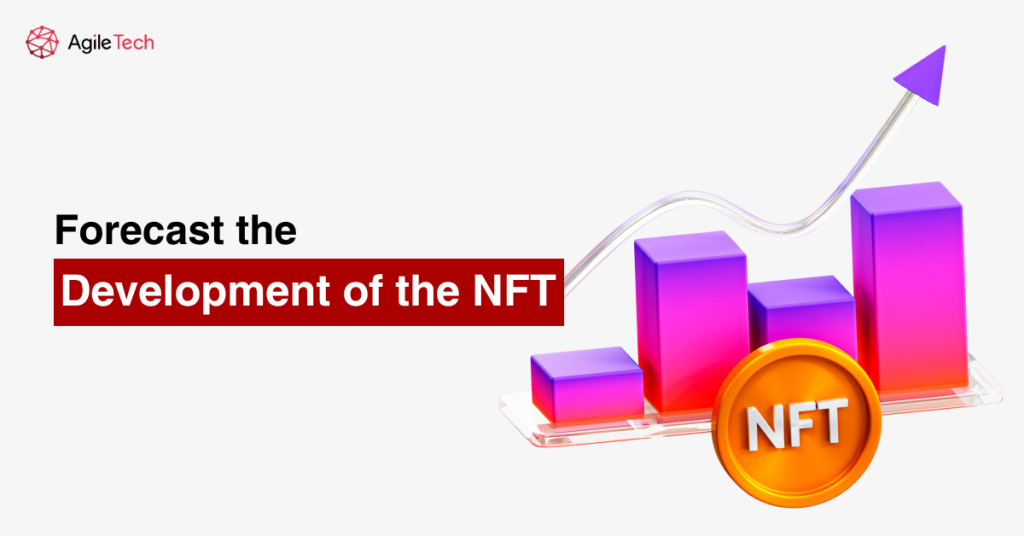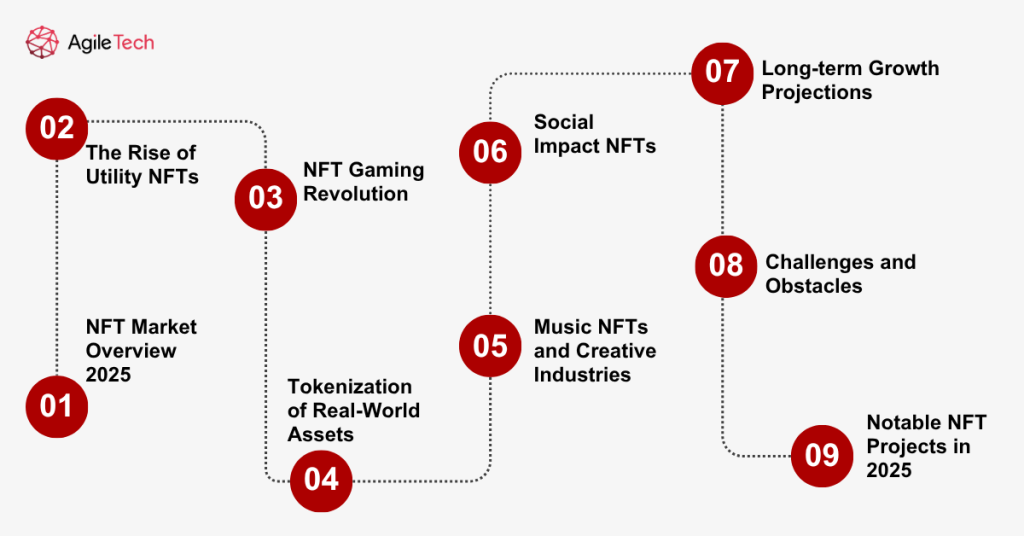Forecast the Development of the NFT in 2025
After experiencing significant fluctuations in recent years, the NFT market is entering a mature phase with new trends and opportunities for sustainable development in 2025. Based on the latest research and analysis, this article provides a comprehensive outlook on the future of NFTs in 2025.

1. NFT Market Overview 2025

The global NFT market is undergoing a significant transformation. According to the latest forecasts, the NFT market is expected to reach $608.6 million in 2025, showing steady growth after a period of strong volatility in previous years. Current data indicates there are 11.58 million NFT users worldwide, and this number is projected to reach 11.64 million by the end of 2025. While this isn’t the explosive growth seen in the early days, it represents stable and sustainable market development.
The shift from speculative trading to utility-focused applications marks a crucial turning point for the industry. Market participants are increasingly prioritizing projects that offer tangible value rather than purely speculative assets. This maturation process reflects the broader evolution of blockchain technology and its integration into mainstream applications.
2. The Rise of Utility NFTs
The most prominent trend in 2025 is the strong development of Utility NFTs, which provide real-world value rather than focusing solely on collectible or artistic elements. These utility-driven NFTs offer holders exclusive access to services, digitized tickets for events and concerts, private and special experiences, and membership benefits within communities. This represents a fundamental shift from the art-focused NFT market of previous years to a more practical, service-oriented ecosystem.
The success of utility NFTs stems from their ability to solve real problems and provide ongoing value to holders. Unlike traditional collectible NFTs that rely primarily on aesthetic appeal or brand recognition, utility NFTs create sustainable demand through their functional applications. This trend is expected to dominate the market throughout 2025 as consumers increasingly demand tangible benefits from their digital asset investments.
Read more: NFT marketplace development
3. NFT Gaming Revolution
The gaming sector continues to lead in NFT transaction volume, revolutionizing how players interact with in-game assets. NFT games allow players to truly own game items including weapons, skins, virtual land, characters and pets, and assets that can be transferred between different games. This creates unprecedented player ownership and economic opportunities within gaming ecosystems.
The integration of NFTs in gaming represents more than just digital ownership; it fundamentally changes the relationship between players and game developers. Players can now invest in games with the knowledge that their in-game achievements and purchases retain value beyond the specific game environment. This paradigm shift is driving significant innovation in game design and monetization strategies, with NFT gaming expected to maintain its strong position and continue growing throughout 2025.
4. Tokenization of Real-World Assets
One of the most promising trends is the tokenization of real-world assets including real estate, luxury goods, traditional artworks, and legal documents. This market could reach $16 trillion by 2030, opening enormous opportunities for NFT development in digitizing real-world assets. The tokenization process makes traditionally illiquid assets more accessible to a broader range of investors while maintaining security and authenticity through blockchain technology.
Real-world asset tokenization addresses long-standing challenges in traditional investment markets by providing fractional ownership opportunities, increased liquidity, and reduced transaction costs. This trend is particularly significant for real estate and luxury goods markets, where high entry barriers have historically limited participation. As regulatory frameworks become clearer and technology improves, tokenized real-world assets are expected to become a major driver of NFT market growth.
5. Music NFTs and Creative Industries
The music NFT sector is experiencing rapid growth, with market forecasts suggesting it could reach $80 billion by 2025. Artists increasingly use NFTs to release exclusive albums, create interactive music experiences, connect directly with fans, and generate new revenue streams. This direct-to-fan model eliminates traditional intermediaries and allows artists to maintain greater control over their work and revenue.
The music industry’s adoption of NFTs extends beyond simple ownership tokens to include experiential elements such as backstage access, exclusive merchandise, and collaborative creation opportunities. This holistic approach to music NFTs creates deeper fan engagement and provides sustainable revenue models for artists at all levels. The success of music NFTs demonstrates the broader potential for creative industries to leverage blockchain technology for innovation and growth.
6. Social Impact NFTs
An emerging trend is the use of NFTs for charitable and social impact purposes. 2025 is expected to witness major charitable organizations hosting NFT auctions, the launch of limited collections for social causes, portion of profits being used for issues like climate change, and community development through NFTs. This trend represents the maturation of the NFT space beyond commercial applications toward meaningful social contributions.
Social impact NFTs leverage the community-building aspects of NFT culture while directing resources toward important causes. These projects often combine artistic value with charitable giving, creating compelling value propositions for socially conscious collectors. The transparency of blockchain technology ensures that charitable contributions can be tracked and verified, building trust in these social impact initiatives.
7. Long-term Growth Projections
Although some sources predict the NFT market may slow down in 2025 with a 11.01% CAGR decline, experts remain optimistic about long-term prospects. The global NFT market is expected to grow 9.10% from 2024-2028, with market size potentially reaching $3.369 billion by 2028. Some positive forecasts suggest the market could reach $247.41 billion by 2029 with a CAGR of 41.9%.
These varying projections reflect the uncertainty inherent in emerging technology markets, but the overall trend points toward sustained growth driven by real-world applications rather than speculative trading. The divergence in forecasts also highlights the importance of focusing on utility-driven projects and sustainable business models rather than relying solely on market speculation.
Read more: How to build NFTs
8. Challenges and Obstacles
Environmental concerns about blockchain’s environmental impact remain a significant challenge, requiring NFT projects to transition to more environmentally friendly blockchains. Additionally, only 27% of NFTs are expected to achieve “Highly Interoperable” status by 2025, indicating substantial work remains to improve value transfer capabilities between platforms. The market also needs clear regulations and improved trustworthiness to attract institutional investors.
These challenges represent both obstacles and opportunities for innovation within the NFT space. Projects that successfully address environmental concerns, improve interoperability, and build trust through transparent practices are likely to gain competitive advantages. The resolution of these challenges will be crucial for the long-term success and mainstream adoption of NFT technology.
9. Notable NFT Projects in 2025
Projects like Pudgy Penguins and Axie Infinity continue to lead trends, particularly in integrating native assets into their NFT ecosystems. These established projects demonstrate the importance of community building, continuous development, and utility integration in maintaining long-term success in the NFT market.
The success of these leading projects provides valuable lessons for new entrants to the market. Their focus on community engagement, regular content updates, and expanding utility demonstrates the key factors necessary for sustained success in the evolving NFT landscape.
Conclusion
The year 2025 marks the maturation phase of the NFT market, transitioning from initial hype to practical applications with real value. With the development of Utility NFTs, NFT gaming, tokenization of real-world assets, and social applications, NFTs are proving their long-term value in the digital economy.
Despite existing challenges, the long-term prospects for NFTs remain highly positive. Investors and businesses should focus on projects with real utility and the ability to create sustainable value for users. The NFT market in 2025 is no longer about explosive growth but about stable, sustainable development that creates real value for society. This fundamental shift toward utility and practical application positions the NFT market for sustained growth and mainstream adoption in the years ahead.